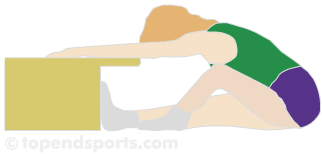This variation of the traditional sit and reach flexibility test is designed to measure the flexibility of the left and right legs separately. Read about the other versions of the sit and reach test.
equipment required: sit and reach box
pre-test: Explain the test procedures to the subject. Perform screening of health risks and obtain informed consent. Prepare forms and record basic information such as age, height, body weight, gender, test conditions. Perform an appropriate warm-up. See more details of pre-test procedures.
procedure: Shoes should be removed first. Sit on the floor with one leg out straight and the other leg with the knee bent and its foot flat on the floor (see image). The outstretched foot is placed flush against the measurement box. With hands placed on top of each other and palms facing down, the subject reaches slowly forward along the measuring line as far as possible. After three practice reaches, the fourth reach is held for at least one second while the distance is recorded. The subject may repeat the test three times and the best score taken. See also video demonstration of the Backsaver Sit and Reach Test.
scoring: The score is recorded to the nearest centimeter or half inch as the distance reached by the tip of the fingers.
 variations: See the general sit and reach procedure page for a list of other sit and reach test variations.
variations: See the general sit and reach procedure page for a list of other sit and reach test variations.
validity: This tests only measures the flexibility of the lower back and hamstrings, and is a valid measure of this.
reliability: The reliability will depend on the amount of warm-up allowed, and whether the same procedures are followed each time.
advantages: It is a easy and quick test to perform. FitnesGram uses the zero mark 9 inches before the feet, meaning that most scores will be a positive number, which is easier to compare and analyze.
disadvantages:
- Variations in arm, leg and trunk length can make comparisons between individuals misleading.
- The version of the test is not commonly performed, so normative values for comparison may not be available.
- Also, this flexibility test is specific to the range of motion and muscles and joints of the lower back and hamstrings, and is not necessarily transferable to other regions. More flexibility tests are required to measure the specific regions of the body.
other comments: In this test, the bent knee can move to the side to allow body to move past it as long as the sole of foot is still on the floor.
The Test in Action
- This is the procedure used for the Brockport, CT Physical Fitness Test and FitnessGram Program.
- This test is also used for the CT Physical Fitness Test, although they call it the 'modified' sit and reach test.
Similar Tests
- The general Sit and Reach test procedure, including links to other versions of the sit and reach test.
Related Pages
- Sit and Reach Test Results.
- Make your own Sit and Reach testing box.
- About the Fitnessgram Test, and purchasing FitnessGram products.
- About the Brockport test battery
- Sit and Reach Test Videos and other Flexibility Test Videos
- Other flexibility tests.
- Hamstring flexibility exercises on this list of stretches.
Related Products
- Sit and reach boxes — see what is available
- Buy a sit and reach box
- Flexibility Store — items to measure flexibility.


 Current Events
Current Events